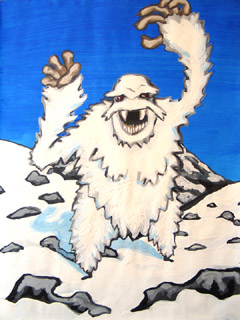you are here [x]: Scarlet Star Studios > the Scarlet Letters > L - The Littlefoot
<< before
K - The King Shielyana
after >>
M - The Mountain Howler
October 14, 2007
L - The Littlefoot
by sven at 8:00 am
Reprinted with permission from Professor Ichbonnsen's Monster Month blog.

The Littlefoot is a white-haired carnivorous mountain ape indigenous to the Himalayas. Like the North American Sasquatch, this animal is an evolutionary descendant of Gigantopithecus -- a 9-foot-tall ape that lived as recently as 100 thousand years ago in China, India, and Viet Nam. At 12 feet tall, the Littlefoot now claims the title for largest ape ever to have walked the Earth.
Despite living in the same region, the Littlefoot bears no relationship to the mythical Yeti. Whereas notable primatologists such Jane Goodall have been convinced that Sasquatch exists, there is a consensus among serious scientists that the Yeti is a product of folklore and hoaxers.
However, that said, there are some important distinctions that must be made. "Yeti" is a catch-all moniker for several supposed animals, which include the Meh-Teh (the "classic" Yeti), the Teh-Lma (a three-foot-tall frog-eating Yeti), and the Dzu-Teh (a giant half-bear, half-ape creature, which walks on all fours). When people discuss the Yeti, it is almost exclusively the Meh-Teh that receives their attention.
My own research confirms that the Meh-Teh is most likely a product of the imagination... But the Dzu-Teh is quite real. It is what the Littlefoot eats.
The Littlefoot has several interesting adaptations that have preserved its anonymity for so long -- leading some to say that the beast is actually unfilmable.
First of all, there are its feet. In stark contrast with the Littlefoot's huge body, it has tiny little flat feet -- which make footprints easily mistaken for those made by a human wearing shoes.
Secondly, the animal lives in deep ice caverns, and only comes out to hunt during severe, near-blinding blizzards. Thus, eye-witness sightings are profoundly unlikely -- and the winds quickly obliterate the already misleading tracks that it leaves behind.
Thirdly, the Littlefoot is an extremely fastidious creature. When it kills its prey, nothing is left behind. It is careful to bring every bit of the Dzu-Teh carcass back to its lair. I have been lucky enough to get a glimpse of the ancestral caverns -- which after so many years, are now like bone cathedrals, meticulously decorated with thousands of old skeletons.
My having finally been able to track down a Littlefoot tribe's cave is almost entirely thanks to another man's misfortune. Three years ago, a fellow cryptozoologist became lost during a blizzard on Mount Shishapangma. He was tracking a Dzu-Teh -- but little did he know that a Littlefoot was just behind him, following the same trail. Camera in hand, he was about to photograph his "Yeti" -- when the Littlefoot struck...
But, just at that moment, an avalanche came tumbling down the mountain and took the lives of all three! Neither the researcher, the Dzu-Teh, nor the Littlefoot were ever found -- but miraculously the camera survived intact.
The story of how the camera came into the hands of the Chinese authorities, got smuggled out of the country, and then found its way to me -- is too involved to tell here. However, I would be remiss not to mention that there is a small movement afoot to rename the Littlefoot after the researcher who died discovering it: "Mullins' Yeti."
Despite my protests that the Littlefoot is an unrelated species, I expect sentimentality will win out and the name will stick.
posted by sven | October 14, 2007 8:00 AM | categories: bestiary